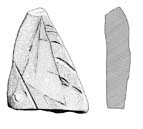Select a site alphabetically from the choices shown in the box below. Alternatively, browse sculptural examples using the Forward/Back buttons.
Chapters for this volume, along with copies of original in-text images, are available here.
Object type: Probable grave-marker
Measurements: (after Rahtz et al. 2000, 263–4) H. max. 36.5 cm (14.25 in); W. max. at base 28 cm (11 in); D. c. 8 cm (3.25 in)
Stone type: Red Triassic sandstone (ibid.)
Plate numbers in printed volume: Pl. 199
Corpus volume reference: Vol 7 p. 147
(There may be more views or larger images available for this item. Click on the thumbnail image to view.)
The stone is a roughly triangular shape with a flattened tip, and is decorated on only one face. This is the flattest face and on it have been incised three lines which radiate from the tip in a triangular formation with a fainter horizontal line which forms an angle at the base. There are futher shallow scratches within the vertical lines and deeper slashes radiating from the right of the vertical incisions. At the left base of the stone a deeper groove cuts at an angle across the vertical line and within the triangle so formed is a neat circular motif.
As the excavator says, 'The decoration is clearly intended to be meaningful, but is not easy to interpret' (Rahtz et al. 2000, 265). Amongst the varied interpretations suggested there by a series of experts, the branching lines on the right have been reasonably interpreted as 'reminiscent of ogham script, as if someone had seen such an ogham without understanding it' (ibid.). The circle at the bottom left has been considered as a simpler form of chi-rho, a sun symbol or even as the letter O, but no one interpretation is utterly convincing. Such simple grave-markers, often incised with branching or crossed lines, are found in Merovingian cemeteries in northern France (Sirat et al. 1984, pls. XVII and XXV) and I have compared these with some of the stones from Wareham in Dorset (pp. 117–18). The Cannington stone is a similar if cruder example and its suggested date would be consonant with these comparisons.
Cannington is sited on a Roman route and within easy reach of the Bristol Channel, and if we are to see these grave-markers as characteristic of cemeteries used by native communities, albeit here under Anglo-Saxon rule, then their links with the Merovingian world and other British-speaking communities like Wareham is explicable.



